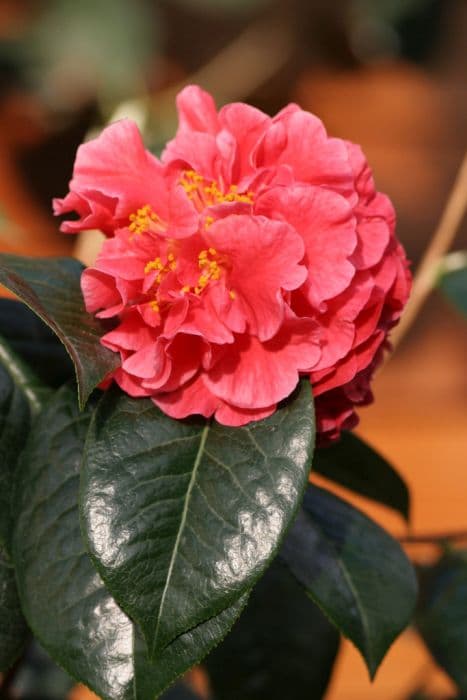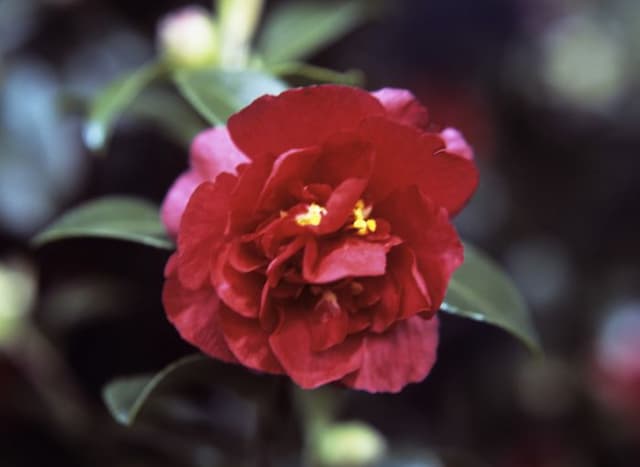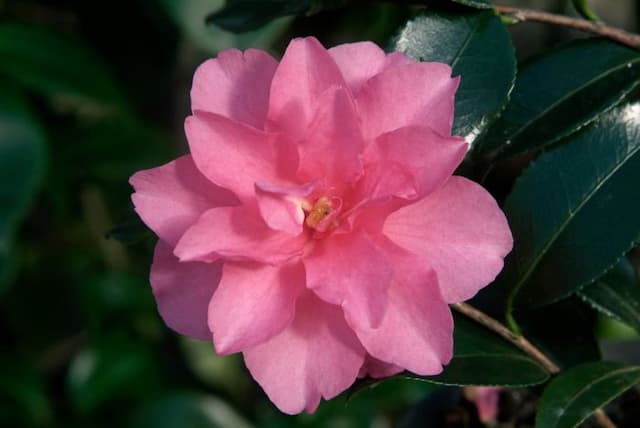Tea Plant Camellia sinensis var. sinensis
ABOUT
The plant commonly known as tea plant has deep green, glossy leaves that are slightly serrated along the edges. The leaves are typically oval-shaped with pointed tips and are arranged alternately on the branches, giving a lush, full appearance to the plant. Young leaves may appear lighter in color, sometimes with a fresh, almost yellowish hue. The tea plant blooms with delicate white flowers, each featuring a yellow center, and they possess a soft, sweet fragrance. The flowers are rather small and consist of multiple petals, giving them a full-bodied look. After flowering, the plant produces small green seed-containing fruits. Overall, the tea plant is known for its distinctive foliage that is harvested to produce tea.
About this plant
 Names
NamesFamily
Theaceae.
Synonyms
Tea Plant, Tea Shrub, Chinese Tea, Camellia Tea, Tea Camellia.
Common names
Thea sinensis, Camellia theifera, Camellia thea, Camellia bohea, Camellia viridis.
 Toxicity
ToxicityTo humans
The most common common name of Camellia sinensis var. sinensis is "tea plant". The tea plant is not considered toxic to humans when consumed in typical beverage quantities. In fact, it is widely consumed around the world in the form of green tea, black tea, and oolong tea. However, consuming large amounts of tea leaves might lead to caffeine-related side effects due to the caffeine content in the leaves, including restlessness, insomnia, headaches, dizziness, irregular heartbeats, and in severe cases, caffeine intoxication. Chronic overconsumption may lead to caffeine overdose with symptoms such as agitation, tremors, stomach upset, and disorientation.
To pets
The most common common name of Camellia sinensis var. sinensis is "tea plant". The tea plant contains caffeine and is therefore potentially toxic to pets, including dogs and cats, if they consume a significant quantity of the leaves. Symptoms of tea plant poisoning in pets can include vomiting, diarrhea, hyperactivity, tremors, increased heart rate, seizures, and in severe cases, collapse or death. Pet owners should ensure their animals do not have access to tea leaves or brewed tea to prevent caffeine toxicity.
 Characteristics
CharacteristicsLife cycle
Perennials
Foliage type
Evergreen
Color of leaves
Green
Flower color
White
Height
5-15 feet (1.5-4.5 meters)
Spread
5-10 feet (1.5-3 meters)
Plant type
Shrub
Hardiness zones
7-9
Native area
Asia
Benefits
 General Benefits
General Benefits- Source of Tea: This variety of Camellia sinensis is primarily cultivated for producing tea, including green, white, and black teas, which are consumed worldwide for their taste and cultural significance.
- Caffeine Content: It contains caffeine, offering a stimulating effect that helps to increase alertness and reduce feelings of fatigue.
- Antioxidants: The leaves are rich in natural antioxidants like catechins, which can protect the body against oxidative stress and support overall health.
- Economic Value: The cultivation and trade of this plant are an important source of income for many tea-growing countries, supporting economies and creating numerous jobs.
- Cultural Importance: Tea made from Camellia sinensis var. sinensis is deeply ingrained in many cultures, playing a central role in social rituals, traditions, and ceremonies.
- Agricultural Diversity: Its cultivation promotes agricultural diversity and can be used in sustainable farming practices as part of a diverse crop system.
- Landscape and Aesthetic Value: The plant itself can contribute to the aesthetic value of landscapes and gardens, where it is sometimes grown ornamentally for its attractive flowers and foliage.
- Soil Health: When grown sustainably, this plant can help to maintain healthy soil conditions and prevent erosion in agricultural areas.
 Medical Properties
Medical Properties- Antioxidant activity: Camellia sinensis leaves contain high levels of polyphenols, such as catechins, which demonstrate antioxidant properties, potentially reducing oxidative stress in the body.
- Cardiovascular health: The polyphenolic compounds in green tea are associated with a reduced risk of cardiovascular diseases by improving blood vessel function and lowering cholesterol levels.
- Cancer prevention: Some studies suggest that catechins in green tea may help prevent cancer cell proliferation and induce apoptosis (programmed cell death) in various types of cancers.
- Anti-inflammatory effects: Green tea components have anti-inflammatory properties, which could contribute to the reduction of inflammation-related diseases.
- Weight management: Green tea extract is believed to help in weight management by promoting fat oxidation and thermogenesis.
- Neuroprotective effects: Catechins may protect neurons from damage, and green tea consumption has been linked to a lower risk of neurodegenerative diseases.
- Glycemic control: Regular green tea consumption has been associated with improved glucose metabolism and a lower risk of type 2 diabetes.
- Dental health: The antimicrobial properties of catechins can inhibit the growth of bacteria in the mouth, potentially reducing the risk of dental caries and periodontal diseases.
- Mental alertness: Green tea contains caffeine and L-theanine, which can help improve cognitive function and increase alertness and focus.
 Air-purifying Qualities
Air-purifying QualitiesThis plant is not specifically known for air purifying qualities.
 Other Uses
Other Uses- Dye Production: The leaves of Camellia sinensis, commonly known as tea, can be used to create a natural dye for fabric, yielding shades of green and brown depending on the processing method.
- Decorative & Craft Material: Dried tea leaves and stems can be incorporated into floral arrangements or used in crafting, such as for making eco-friendly confetti or in papermaking.
- Insect Repellent: The strong scent of tea leaves can be used to repel insects, especially in pantry areas where dry leaves might deter pests like moths and beetles.
- Culinary Flavoring: Smoked tea leaves, such as those from lapsang souchong, can be used to impart a smoky flavor to various dishes, including meats and cheeses.
- Odor Neutralizer: The leaves can be placed in refrigerators, closets, or shoes to help absorb and neutralize bad odors, due to their natural odor-absorbing properties.
- Fire Starter: Dried tea leaves have a low ignition point, making them suitable for use as a natural fire starter in barbecues or campfires.
- Fish Tank Decoration: After thorough cleaning, branches from tea plants can be used as natural and aesthetically pleasing decorations in aquariums.
- Composting Material: Tea leaves are rich in nutrients and can be added to compost heaps to enrich the compost and help speed up the composting process.
- Hair Tinting: Using strong brewed tea can add a subtle tint or enhance the natural color of one’s hair, providing a gentle and natural alternative to chemical dyes.
- Plant Growth Stimulant: Weaker brews of tea can be used to water other plants, as the tea may contain nutrients and slight acidity that can be beneficial for plant growth.
Interesting Facts
 Feng Shui
Feng ShuiThe tea plant is not used in Feng Shui practice.
 Zodiac Sign Compitability
Zodiac Sign CompitabilityThe tea plant is not used in astrology practice.
 Plant Symbolism
Plant Symbolism- Longevity: The Camellia sinensis var. sinensis, commonly known as the tea plant, is an evergreen shrub that can live for many years, making it a symbol of longevity and endurance.
- Stability: Just as this plant forms the foundation for the wildly popular beverage tea, it signifies stability and reliability in the cultural traditions of people who cultivate it.
- Peace: Tea is often associated with relaxation and meditation, with the tea plant likewise symbolizing peace and tranquility.
- Prosperity: In many tea-producing regions, the plant represents economic prosperity and wealth due to the industry and trade surrounding tea.
- Health: Given the numerous health benefits attributed to tea, the Camellia sinensis var. sinensis symbolizes health and well-being.
 Water
WaterTea plants require consistent moisture and should be watered every week with 1-2 gallons of water, depending on the size of the plant and the climate. During dry spells, increase watering to twice a week. It's crucial to water the base of the plant without wetting the leaves to prevent fungal diseases. Allow the top inch of soil to dry out between watering to encourage deep root growth. Overwatering can lead to root rot, so be cautious not to let the plant sit in waterlogged soil.
 Light
LightTea plants prefer bright, indirect light with protection from the hot afternoon sun. A location with morning sunlight and dappled shade in the afternoon is ideal for the tea plant. Ensure the plant receives at least a few hours of sunlight daily to maintain healthy growth but avoid exposure to intense midday rays which can damage the foliage.
 Temperature
TemperatureTea plants thrive in a temperature range of 65-85°F and can tolerate minimum temperatures down to around 30°F for brief periods. Optimal growth occurs in the warmer end of this spectrum, and it's essential to protect the plant from frost, which can severely damage or kill it. The ideal conditions for a tea plant include a consistent, mild climate without extreme temperature fluctuations.
 Pruning
PruningPrune tea plants annually to maintain health and shape, typically in late winter or early spring before new growth starts. Remove dead or damaged branches, thin out any crowded areas to improve air circulation, and trim back to encourage bushy growth and more tea leaves. Severe pruning isn't necessary unless the plant has become overgrown.
 Cleaning
CleaningAs needed
 Soil
SoilTea plant, commonly known as Camellia sinensis, thrives best in slightly acidic soil with a pH of 6.0 to 6.5. A good soil mix consists of equal parts of ericaceous compost and pine bark with some perlite for improved drainage and aeration.
 Repotting
RepottingTea plants, Camellia sinensis, should be repotted approximately every 2-3 years or when they become root-bound in their container, to ensure continued growth and health.
 Humidity & Misting
Humidity & MistingCamellia sinensis, generally known as the tea plant, prefers high humidity levels, ideally between 70% and 90%, to mimic its native tropical and subtropical growing conditions.
 Suitable locations
Suitable locationsIndoor
Keep Camellia sinensis in bright, indirect light; water well.
Outdoor
Plant Camellia sinensis in partial shade and shelter from wind.
Hardiness zone
7-9 USDA
 Life cycle
Life cycleThe life of the tea plant (Camellia sinensis var. sinensis) begins with seed germination, typically in a nursery bed, where it develops a strong root system and foliage. After 1-3 years, the young tea plant is transplanted to a tea garden where it matures over several years before it reaches a suitable size for commercial harvesting. During the vegetative stage, the plant grows continuously, producing new shoots which, after reaching a certain maturity, are plucked for tea production. The reproductive stage starts with the tea plant flowering, usually after it is three years old, although flowers are rarely allowed to bloom fully as priority is given to leaf harvesting. If the flowers are pollinated, they develop into fruit with seeds, which can be collected and sown to propagate new plants. The tea plant can remain productive for over 30 to 50 years, after which yield and quality can decline, leading to replanting.
 Propogation
PropogationPropogation time
Spring to early summer
Propogation: The most popular method for propagating the tea plant, Camellia sinensis var. sinensis, is through semi-hardwood cuttings. This is typically done from late summer to early autumn, when the plant has matured but the wood is not yet completely hardened. A 4 to 6-inch cutting is taken from the current year's growth, and the leaves on the lower half are removed. The cut end is then dipped in rooting hormone to enhance root development and placed in a well-draining soil mix. This cutting should be kept under high humidity conditions and out of direct sunlight to encourage root growth. It can take several weeks to a few months for the cutting to root successfully.









